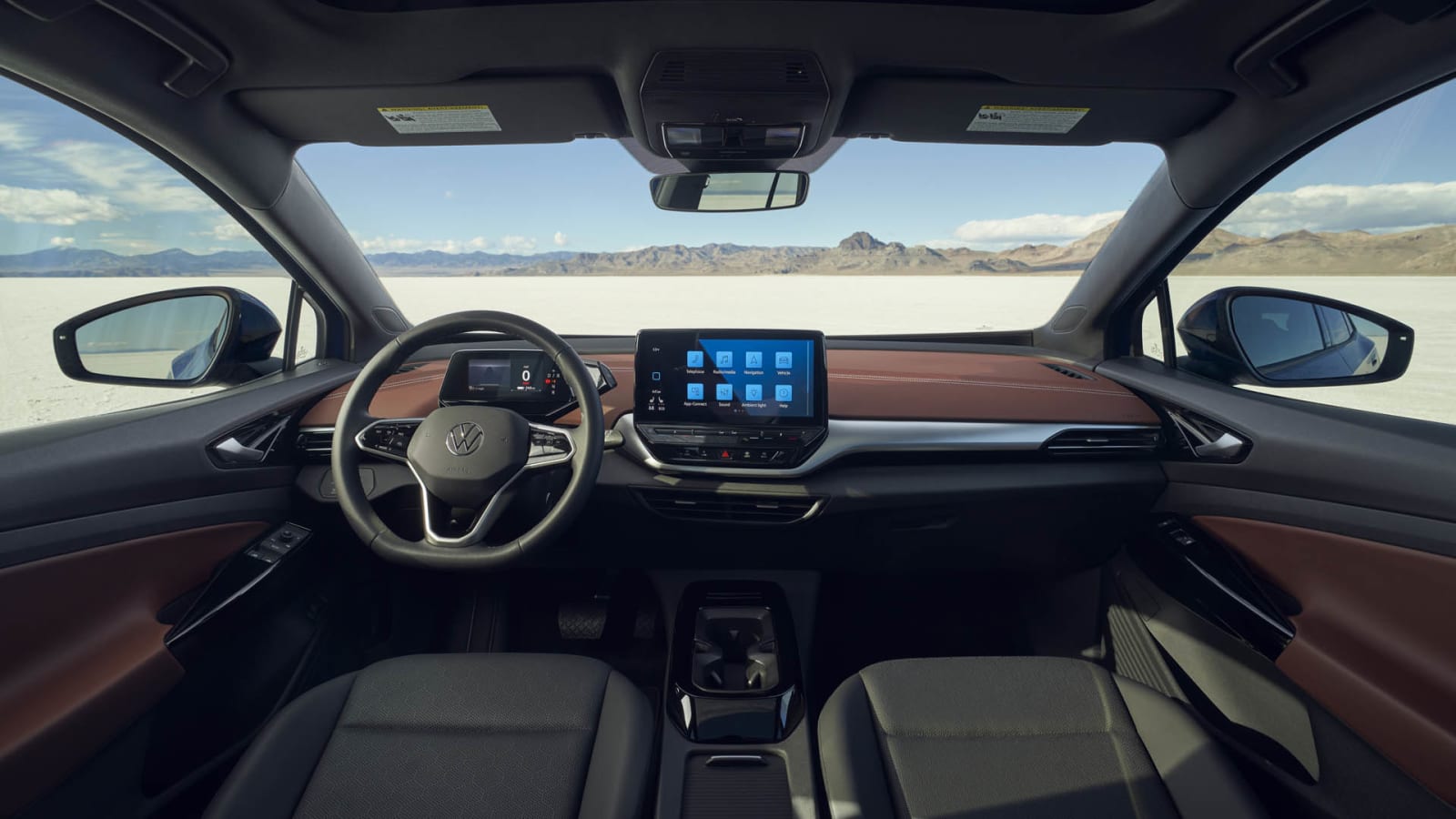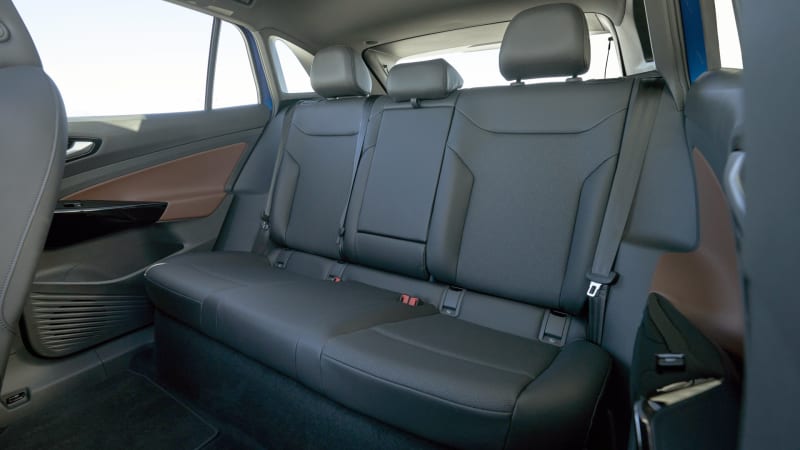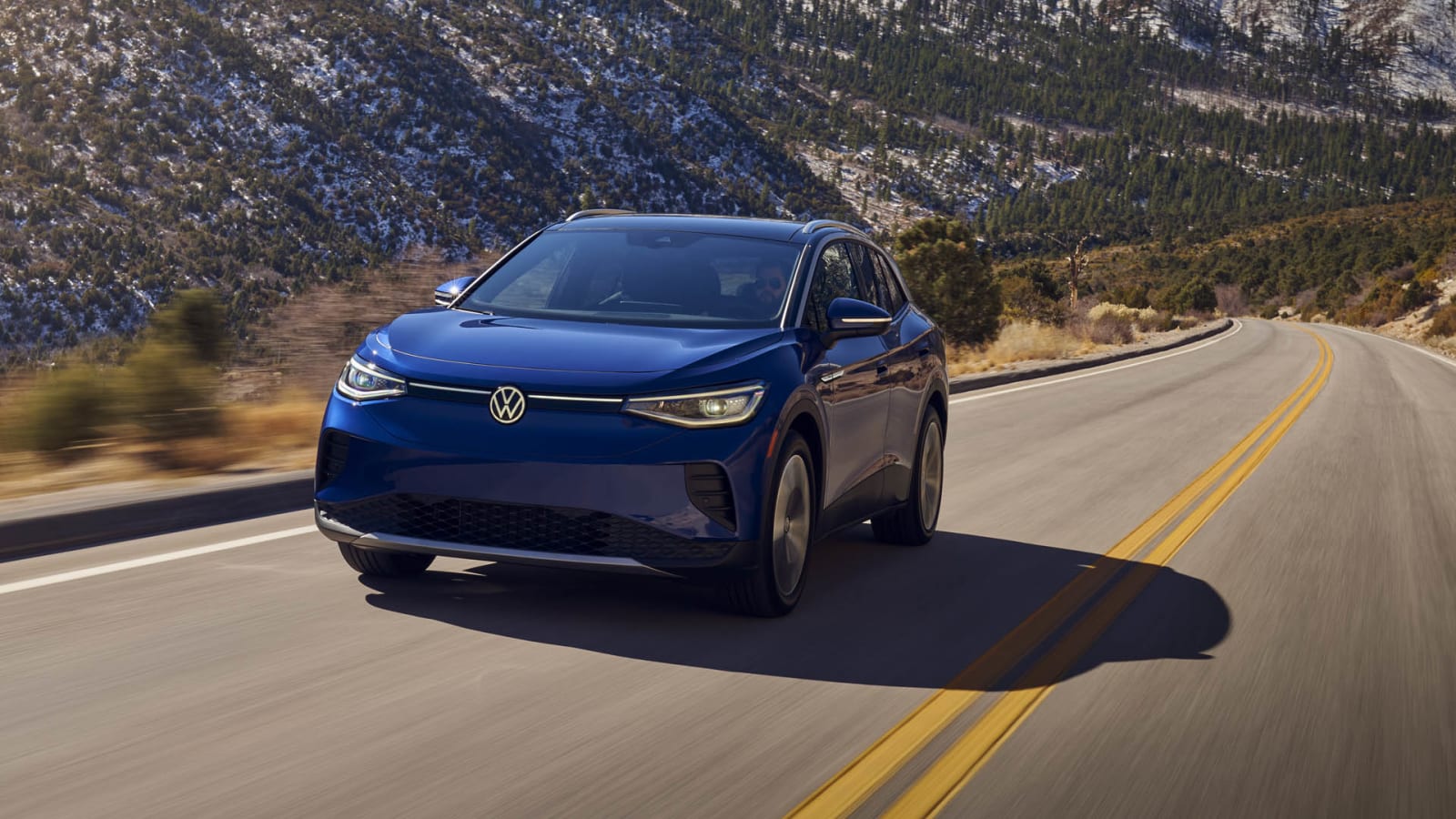In the wake of its historic diesel-emissions scandal, Volkswagen says it is reinventing itself as an electric-car company. In its home market, the first dedicated battery-electric vehicle was the ID.3, a compact hatchback. In America, however, buyer interest in small hatchbacks is waning, while U.S. car buyers are mad for crossovers. So, here in the USA, the model spearheading the charge is the new 2021 Volkswagen ID.4, a compact crossover. And much like VW’s existing lineup of gas-powered vehicles, the ID.4 largely plays it safe with a design, configuration, and driving experience that seek to appeal to the widest possible swath of buyers. It’s hard to fault that strategy, but VW also might’ve played it a bit too safe.
The VW ID.4 currently is offered with a single powertrain configuration: a 201-horsepower rear motor driving the rear wheels and fed by an 82-kWh battery pack good for a range of 250 miles. A dual-motor AWD version with around 300 horsepower arrives later in 2021. In terms of size, the ID.4 is perfectly average for a compact crossover — it provides a sufficient amount of passenger and cargo, but does falls short of the Honda CR-V, Toyota RAV4 and VW’s own Tiguan. Ultimately, the ID.4’s price could be one of its biggest selling points. Starting at $41,190, it’s eligible for at least the $7,500 federal tax credit which massively cuts the purchase price or monthly lease payment. When you consider that electricity will cost less than 87 octane and that VW even throws in three years of free charging at Electrify America stations, its value compared to gas-only SUVs only increase.
What’s new for 2021?
The ID.4 is a completely new entry for 2021. Its rounded, blob-like styling takes an opposite tack from the straight edges and square-off shapes that characterize the rest of the VW lineup. The most futuristic aspects of the ID.4’s look are its LED headlights and grille-less visage. Otherwise, this crossover blends into the sea of crossovers that fill America’s parking lots.
What are the ID.4 interior and in-car technology like?
The ID.4’s interior and in-car technology are the most avant-garde aspects of the entire car — for better and worse. The style is hyper-modern, with capacitive-touch switches, a dearth of physical knobs and buttons, and (on the 1st Edition) lots of gloss-white plastic — that’s replaced with more conventional-looking gloss black on the other trims. Behind the steering wheel is a small digital instrument cluster that’s mounted to the steering column not the dash. Sprouting to its right is a trapezoidal-shaped knob that’s the gear selector; twist one way for Drive, the other for Reverse. Push a button at the end for Park.
The dash is dominated by a 12-inch central display (10-inch in the base model), which looks good and is fairly easy to use. The same cannot be said, however, of most of the controls outside the screen. Annoyingly, nearly all functions are touch-activated, meaning audio volume and climate controls utilize maddening touch-sliders. And formerly simple operations like operating electric windows or adjusting the side mirrors have a new layer of complication. A regular driver likely would learn the ID.4’s quirks, but there’s really no benefit to any of this nonsense.

How big is the ID.4?
In most exterior measures the ID.4 is a few inches smaller than the VW Tiguan. The Tiguan, though, is one of the larger entrants in the compact SUV segment, so the ID.4 ends up right in the heart of the segment, size-wise. A Mazda CX-5 is a decent analog. At 180.5 inches long, it’s 1.5 inches shorter than a Honda CR-V and a fraction of an inch shorter than a Toyota RAV4. The ID.4 rides on a relatively long 108.9-inch wheelbase, however, which is just over 4 inches longer than the Honda’s and 3 inches longer than the Toyota’s. At 73 inches, width is virtually identical to the CR-V and RAV4.
Volkswagen packages the ID.4’s batteries under the passenger floor, and the motor is located at the rear under the cargo floor. As a result, there’s slightly less room for passengers and cargo in the ID.4 than in the two leading compact crossovers. Rear-seat legroom is a couple inches less than the CR-V but about equal to the RAV4. The 30.3 cubic feet of luggage space behind the rear seats and 64.2 cubic feet with the rear seatbacks folded again is somewhat less than in the Honda (39.2/75.8) and Toyota (37.6/69.8). Still, there’s sufficient room for adults in the front and rear, and the flat rear floor helps make the middle position tolerable.
What are the ID.4’s range and performance specs?
The ID.4 will initially be available with one powertrain combination: a 82-kilowatt-hour battery pack powers a rear motor good for 201 horsepower and 229 pound-feet of torque. Expect a 0-60 time in the mid-8-second range, which is a bit slow for a compact crossover. A dual-motor version with around 300 horsepower and all-wheel drive is slated to join the lineup later in 2021. It should shave about 2 seconds off the 0-60 time, which would be quick for the segment.
The EPA-estimated range for the single-motor ID.4 is 250 miles. Unlike some competitors, there is no option to upgrade to a larger battery pack with a longer range. This puts it square in the middle of affordable EV models, most notably the smaller Chevy Bolt EUV, Hyundai Kona Electric and Kia Niro EV. Pricier versions of the Tesla Model Y and Ford Mustang Mach-E can go further.
As part of its penance for its diesel emissions cheating, VW is spending heavily on the Electrify America network of EV chargers, and buyers get three years of free charging at the network’s sites, 555 at last count. Recharging would take about 7.5 hours with a Level 2 charger, while VW says an ultra-powerful 125-kW public charger can take the battery pack from 5% to 80% charged in just under 40 minutes.
What’s the ID.4 like to drive?
The EV aspects of the driving experience are somewhat muted in the ID.4. We drove the single-motor 1st Edition version, and although the full measure of the motor’s torque is available immediately, 229 lb-ft is not a lot to bring to bear against the ID.4’s considerable weight. Acceleration, then, is merely adequate, offering none of the ludicrous thrills that higher-output EVs can provide.
The VW’s regenerative brakes have a fairly natural feel. Drivers can dial in a higher level of regenerative braking by shifting to “B,” but it’s not quite enough to achieve the “one-pedal driving” that many EV drivers appreciate.
And while rear-wheel drive and an ultra-low center of gravity would seem to be a recipe for GTI-beating handling, the ID.4 chassis is tuned instead for comfortable, sedate cruising. The steering is very light, and the suspension is more about soaking up bumps than carving corners. The low noise levels add to the relaxed vibe.
What other Volkswagen ID.4 reviews can I read?
2021 VW ID.4 First Drive Review
In our first drive of the ID.4 we find that VW’s mainstream approach seems right, but wondering it might result in it blending into the background of both the compact SUV and EV markets.







